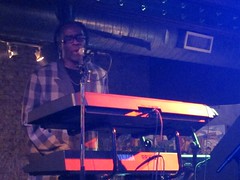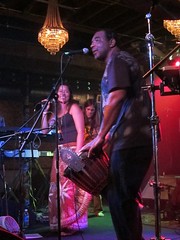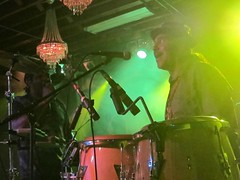4 February 2015 (Aggie Theatre, Ft. Collins CO, Ft. Collins CO)
3.5/5.0



There's no better way to fight the February chill than soaking in the warm sounds of the islands. Hawaiian band The Green brought their pop-flavored reggae to the Aggie as part of their Chocolate & Roses tour. While the venue wasn't packed, the enthusiastic audience was clearly familiar with the band's songs. Their opening act, San Diego's Through the Roots, was a good pairing. Neither band is locked into a slavish interpretation of reggae, but both were able to draw on the power of the one-drop to share their positive messages.
 Through the Roots made a strong impression with their first song. The electronic intro swirled around a vocal clip of Bob Marley talking about richness, creating an electro-dub vibe before the band dropped into "Dancing in the Rain". The synth element proved to be a big part of their sound, with keyboard driven bass lines, thickly reverbed drums, and lots of toys to warp the guitar tone. Even when bass player Budda Foster switched to bass guitar, it was so heavily processed, that it sounded more produced than his keyboard riffs.
Through the Roots made a strong impression with their first song. The electronic intro swirled around a vocal clip of Bob Marley talking about richness, creating an electro-dub vibe before the band dropped into "Dancing in the Rain". The synth element proved to be a big part of their sound, with keyboard driven bass lines, thickly reverbed drums, and lots of toys to warp the guitar tone. Even when bass player Budda Foster switched to bass guitar, it was so heavily processed, that it sounded more produced than his keyboard riffs.
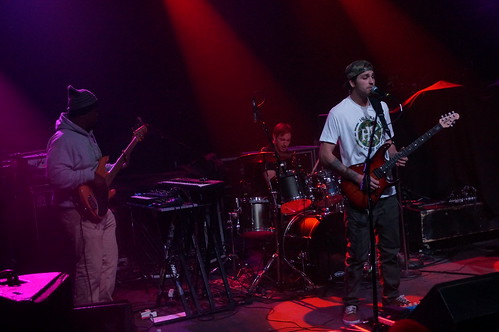
The band moved even further away from the purist reggae ideal on their next tune, which relied on heavier rock guitar. Throughout the set, lead guitarist Scott Curtis rarely slipped into the standard repetitious fill that's ubiquitous in reggae. Instead, he approached the songs from a modern rock perspective. This led to some very interesting interludes, where the whole band fell together on a common melodic theme to break up the flow of laid-back, mid-tempo beats.
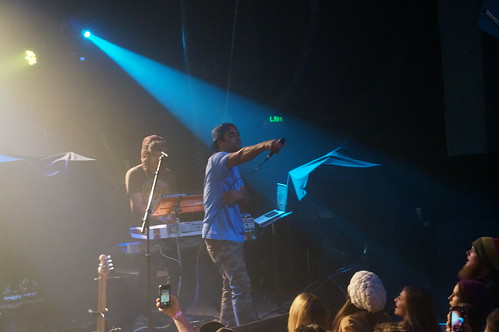
Lead singer and rhythm guitarist Evan Hawkins added the third key element to the band's "Cali-reggae" sound, with a strong R&B vocal style that complemented the positive lyrics. He showed off a good range, but most of the time, his casual stage presence didn't generate as much energy as his shout outs on behalf of The Green. This made their set less about any player's personality and more about the group's tight musicianship. Those coordinated riffs to shake things up were just the start. Through the Roots had clearly polished their arrangements and thought a lot about their song transitions. While they didn't overshadow The Green, they served as a tasty appetizer for the main course.
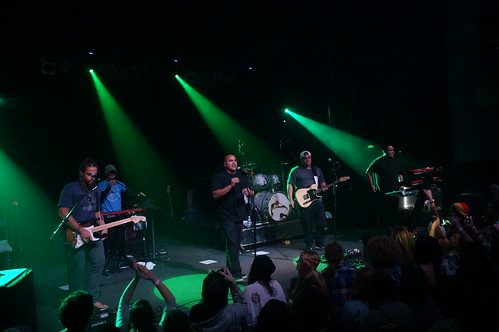
The soulful pop spine of The Green's last release, Hawai'i 13 (2013, review here), combined with the chill set from Through the Roots, had me expecting a fairly relaxed performance, but The Green set me straight right away. A dramatic soundtrack built up the anticipation as they took the stage and they quickly jumped right into the steady groove of "Good One". Where the album version is a soothing philosophical reaction to over-indulgence ("It must have been a good time, baby, whoa"), this take was more immersed in the party mood that preceded the hangover. Charismatic lead singer Caleb Keolanui worked the crowd and radiated a loose exuberance that sold the song.

By the time they had played four or five tunes, the whole front line on stage had taken their turns at lead vocals, That versatility kept the audience engaged, While the singers weren't interchangeable -- guitarist JP Kennedy had a rawer raspy tone with rich, warm character and each tune pulled in the right persona to serve the song -- the handoffs distributed people's attention from one end of the stage to another. Also, when they pooled together on harmonies, it was easy to hear their Hawaiian roots in the sweet mix.
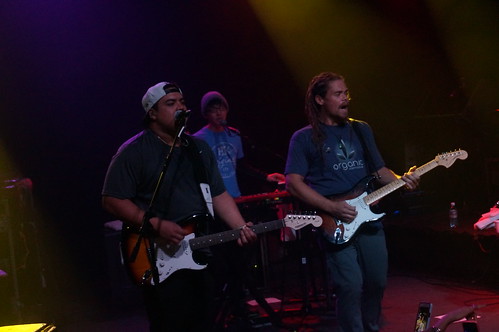
None of that should eclipse the backline rhythm section. BW Watanabe's keyboard bass lines filled out the bottom end and felt organic enough that I never missed a bass guitar in the mix. While he covered backing vocals and assorted keyboard comping above and beyond the bass, he seemed happy to lurk in the background, which didn't do full justice to his contribution. It was a treat watching him cover the fat low end, but still nail the sharp synth stabs or add the understated textures that filled out the sound. Drummer Jordon Espinoza by contrast played large, proving himself a master of fills. This drove the looser live feel, but never compromised the fundamental groove of the music.
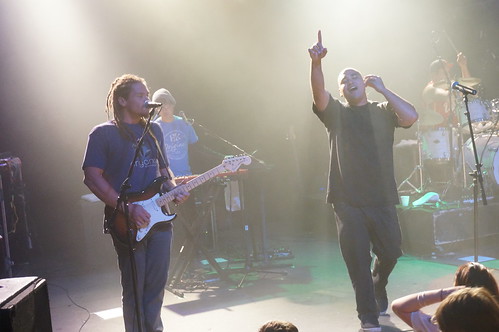
As The Green smoothly flowed through their setlist, it was clear that they had worked out the dynamic progression for maximal impact. Songs found their own climaxes, but they never neglected the tenor of the whole performance. Drop out breaks accentuated the higher intensity moments and lazy grooves led to bigger builds. In particular, it would have been easy for them to lose momentum when they explored a moodier groove, like during "Never", but they maintained a taut focus that served to set up the the big beat funky chank of "Rootsie Roots".
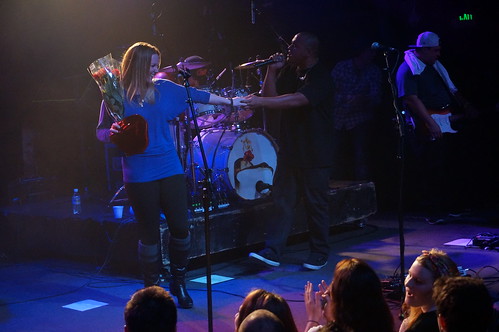
Given that the tour was named after the band's most soulful number, "Chocolate & Roses", the crowd was primed to hear that gem of pop perfection, and it seemed like The Green was ready to deliver it late in their set. Easing into the jazzy soul vamp, Keolanui dedicated the groove to the ladies in the audience and they responded enthusiastically. As the intro stretched out, he riffed on Minnie Riperton's "Lovin' You", "Loving you is easy, cause you're beautiful", but it was all a feint. They wouldn't pull out the tune until their encore, but they made up for it then by bringing a representative woman on stage to serve as a focal point. She danced with poise and graciously received literal chocolate and roses as Keolanui's serenaded her. The arrangement incorporated some bigger dynamic swings that upped the emotional ante, but they avoided any sense of irony and pastiche, preserving the purity of the tune.
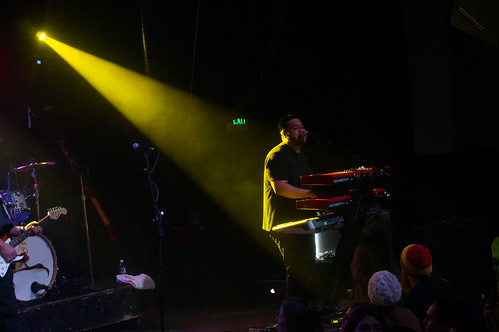
Hawaii may be geographically far from Jamaica, but The Green made the island connection work with a high energy, positively conscious performance.
More photos on my Flickr.
3.5/5.0




There's no better way to fight the February chill than soaking in the warm sounds of the islands. Hawaiian band The Green brought their pop-flavored reggae to the Aggie as part of their Chocolate & Roses tour. While the venue wasn't packed, the enthusiastic audience was clearly familiar with the band's songs. Their opening act, San Diego's Through the Roots, was a good pairing. Neither band is locked into a slavish interpretation of reggae, but both were able to draw on the power of the one-drop to share their positive messages.
 Through the Roots made a strong impression with their first song. The electronic intro swirled around a vocal clip of Bob Marley talking about richness, creating an electro-dub vibe before the band dropped into "Dancing in the Rain". The synth element proved to be a big part of their sound, with keyboard driven bass lines, thickly reverbed drums, and lots of toys to warp the guitar tone. Even when bass player Budda Foster switched to bass guitar, it was so heavily processed, that it sounded more produced than his keyboard riffs.
Through the Roots made a strong impression with their first song. The electronic intro swirled around a vocal clip of Bob Marley talking about richness, creating an electro-dub vibe before the band dropped into "Dancing in the Rain". The synth element proved to be a big part of their sound, with keyboard driven bass lines, thickly reverbed drums, and lots of toys to warp the guitar tone. Even when bass player Budda Foster switched to bass guitar, it was so heavily processed, that it sounded more produced than his keyboard riffs.
The band moved even further away from the purist reggae ideal on their next tune, which relied on heavier rock guitar. Throughout the set, lead guitarist Scott Curtis rarely slipped into the standard repetitious fill that's ubiquitous in reggae. Instead, he approached the songs from a modern rock perspective. This led to some very interesting interludes, where the whole band fell together on a common melodic theme to break up the flow of laid-back, mid-tempo beats.

Lead singer and rhythm guitarist Evan Hawkins added the third key element to the band's "Cali-reggae" sound, with a strong R&B vocal style that complemented the positive lyrics. He showed off a good range, but most of the time, his casual stage presence didn't generate as much energy as his shout outs on behalf of The Green. This made their set less about any player's personality and more about the group's tight musicianship. Those coordinated riffs to shake things up were just the start. Through the Roots had clearly polished their arrangements and thought a lot about their song transitions. While they didn't overshadow The Green, they served as a tasty appetizer for the main course.

The soulful pop spine of The Green's last release, Hawai'i 13 (2013, review here), combined with the chill set from Through the Roots, had me expecting a fairly relaxed performance, but The Green set me straight right away. A dramatic soundtrack built up the anticipation as they took the stage and they quickly jumped right into the steady groove of "Good One". Where the album version is a soothing philosophical reaction to over-indulgence ("It must have been a good time, baby, whoa"), this take was more immersed in the party mood that preceded the hangover. Charismatic lead singer Caleb Keolanui worked the crowd and radiated a loose exuberance that sold the song.

By the time they had played four or five tunes, the whole front line on stage had taken their turns at lead vocals, That versatility kept the audience engaged, While the singers weren't interchangeable -- guitarist JP Kennedy had a rawer raspy tone with rich, warm character and each tune pulled in the right persona to serve the song -- the handoffs distributed people's attention from one end of the stage to another. Also, when they pooled together on harmonies, it was easy to hear their Hawaiian roots in the sweet mix.

None of that should eclipse the backline rhythm section. BW Watanabe's keyboard bass lines filled out the bottom end and felt organic enough that I never missed a bass guitar in the mix. While he covered backing vocals and assorted keyboard comping above and beyond the bass, he seemed happy to lurk in the background, which didn't do full justice to his contribution. It was a treat watching him cover the fat low end, but still nail the sharp synth stabs or add the understated textures that filled out the sound. Drummer Jordon Espinoza by contrast played large, proving himself a master of fills. This drove the looser live feel, but never compromised the fundamental groove of the music.

As The Green smoothly flowed through their setlist, it was clear that they had worked out the dynamic progression for maximal impact. Songs found their own climaxes, but they never neglected the tenor of the whole performance. Drop out breaks accentuated the higher intensity moments and lazy grooves led to bigger builds. In particular, it would have been easy for them to lose momentum when they explored a moodier groove, like during "Never", but they maintained a taut focus that served to set up the the big beat funky chank of "Rootsie Roots".

Given that the tour was named after the band's most soulful number, "Chocolate & Roses", the crowd was primed to hear that gem of pop perfection, and it seemed like The Green was ready to deliver it late in their set. Easing into the jazzy soul vamp, Keolanui dedicated the groove to the ladies in the audience and they responded enthusiastically. As the intro stretched out, he riffed on Minnie Riperton's "Lovin' You", "Loving you is easy, cause you're beautiful", but it was all a feint. They wouldn't pull out the tune until their encore, but they made up for it then by bringing a representative woman on stage to serve as a focal point. She danced with poise and graciously received literal chocolate and roses as Keolanui's serenaded her. The arrangement incorporated some bigger dynamic swings that upped the emotional ante, but they avoided any sense of irony and pastiche, preserving the purity of the tune.

Hawaii may be geographically far from Jamaica, but The Green made the island connection work with a high energy, positively conscious performance.
More photos on my Flickr.


 Carrying on the family business is a long-standing tradition and the entertainment industry is no different. But even talent and the support of famous parents are no guarantee for success. Now put yourself in Julian Lennon's shoes or imagine the Marley offspring, trying to make a mark with the burden of a mythic, almost saintly father. They've each had to carry that weight and face down the unmeetable expectations. But where Julian Lennon has never completely exorcised his father's ghost, the Marleys have overcome the overblown hype and dismissive critics to prove that they had more going on than just their celebrity genetics. Eldest son Ziggy probably faced the harshest criticism, but his younger brothers have each taken their turns, too. With perseverance, they've gone on to earn Grammys and chart success while finding their own voices. In recent years, brothers Stephen, Julian, and Damian Marley have focused their attention on their label,
Carrying on the family business is a long-standing tradition and the entertainment industry is no different. But even talent and the support of famous parents are no guarantee for success. Now put yourself in Julian Lennon's shoes or imagine the Marley offspring, trying to make a mark with the burden of a mythic, almost saintly father. They've each had to carry that weight and face down the unmeetable expectations. But where Julian Lennon has never completely exorcised his father's ghost, the Marleys have overcome the overblown hype and dismissive critics to prove that they had more going on than just their celebrity genetics. Eldest son Ziggy probably faced the harshest criticism, but his younger brothers have each taken their turns, too. With perseverance, they've gone on to earn Grammys and chart success while finding their own voices. In recent years, brothers Stephen, Julian, and Damian Marley have focused their attention on their label,  Let the island rhythms relax you. Let go and surrender to physical bliss of the warm climate and gentle breezes. Dig your toes into the sand and feel for the roots of a rich cultural expression. Hawaii’s premier reggae band,
Let the island rhythms relax you. Let go and surrender to physical bliss of the warm climate and gentle breezes. Dig your toes into the sand and feel for the roots of a rich cultural expression. Hawaii’s premier reggae band, 














 As the house band for Easy Star records, the
As the house band for Easy Star records, the  After catching
After catching 


